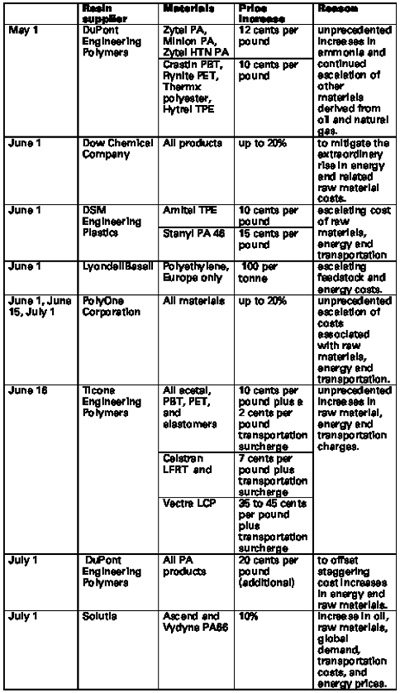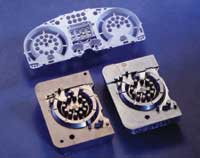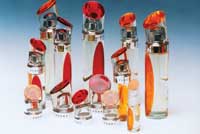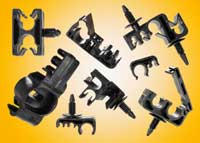Injection machine shipments down, says SPI
July 1, 2008
Injection machine shipments down, says SPI
You can blame high resin and energy costs for the flat 2008 forecast of primary plastics machinery and equipment from U.S. manufacturers and imports, according to the Society of the Plastics Industry (Washington DC; www.plasticsindustry.org). SPI’s Committee on Equipment Statistics released its Q1 2008 figures for these shipments in mid-June. Total demand for plastic products resulting from declines in residential construction and U.S. automotive are other causes.
While overall the $227 million worth of primary machinery (excluding components and auxiliary equipment) is 4% higher than Q1 2007 and 8% higher than Q4 2007, the increase comes from blowmolding and extrusion machines. Injection molding machinery units were down 4% from Q1 2007 and down 11% from last quarter.
On the bright side, orders for industrial equipment “should rebound late this year and through 2009,” says economist Bill Wood, who provided the analysis in SPI’s recent report. Wood adds that construction and automotive should start to see consistent growth in 2009. —AC
BPA-free blender container ahead of the curve
|
While the BPA (bisphenol-A) debate continues unabated this summer (www.immnet.com/articles/2008/May/3645), one company took the lead in converting its products as early as last October. That’s when Vita-Mix (Olmsted Falls, OH) announced it would begin using a BPA-free copolyester material called Tritan from Eastman (Kingsport, TN; www.eastman.com) instead of polycarbonate to mold the containers for the newly developed Vita-Mix 5200 blender.
Tritan was selected after designers tested a number of alternative materials for the container, according to Vita-Mix. It was the only BPA-free material that could maintain the levels of impact resistance the containers must have. In addition, it offered clarity and heat resistance with a reduced risk of crazing, cracking, or hazing.
Laszeray Technology (North Royalton, OH), one of Vita-Mix’s molded parts suppliers, says it was able to produce the containers without complicated changes to its molding process. The molder also reports that the new -generation copolyester is easy to process and can be used in molds designed for polycarbonate with only minor modifications. —MM
Xaloy adds rep for TX, NM, and Mexico
Screw and barrel manufacturer Xaloy (New Castle, PA; www.xaloy.com) has appointed Bernal Industrial Inc. (El Paso, TX) to represent its melt delivery systems in Texas, New Mexico, and—in Mexico—Chihuahua and Sonora. —AC
 Up, up, and away
Up, up, and away
While the pain is no less real, it’s not much of a surprise to industry watchers that most major resin suppliers have announced price increases in the past four weeks. The driving force behind the mass migration upward is, as usual, the cost of crude oil.
According to a Bloomberg news report, oil prices reached record heights of $133 per barrel in May, and are currently hovering around $123 per barrel. This is an 89% increase from a year ago. A report from Goldman Sachs expects the overall rise to last. Its analysts predict long-date oil prices will climb 14% to $148 a barrel by early next year.
Bloomberg reported that the plastics industry will be among the hardest hit as raw material price volatility continues. The following table of price increase announcements gives credence to that observation. (All increases apply to North America unless otherwise noted). —MM

President George W. Bush presented the President’s E-Award Certificate for Exports to Arthur Haag, President of Neutrex Inc.
Kudos for purging compound exports
An increase in exports of U.S.-made products is always worth taking note, and on May 20, President Bush recognized a company in our own industry that has doubled its export sales from 2004-2007. Neutrex Inc. (Houston, TX; www.purgexonline.com) received the President’s E Award Certificate for Exports, recognizing the company’s achievement in supporting export growth in the U.S. business community through sales of its Purgex commercial purging compounds. The award, as described by the U.S. Commerce Dept., “was created by Executive Order of the President on Dec. 5, 1961, to afford suitable recognition to persons, firms, or organizations which contribute significantly in the effort to increase United States exports.” —AC
SPI’s Carteaux appointed to Labor Dept. advisory group
SPI (Society of the Plastics Industry) president William R. Carteaux has been invited to join the Advisory Committee on Apprenticeship (ACA; www.doleta.gov/OA/ACA.cfm), a group created by the U.S. Labor Dept. to solicit advice and recommendations from employers, labor organizations, and the public. U.S. Secretary of Labor Elaine Chao requested Carteaux to serve as a representative of the employer sector. The group is composed of about 30 members, who are appointed for one- or two-year terms, and advises the Labor Secretary on policies and legislation related to apprenticeship, American workforce training, measures for safe and fair workplaces, and strategies for competing in the global economy. —AC
 KraussMaffei expands in Eastern Europe
KraussMaffei expands in Eastern Europe
Following record orders of a1.06 billion for the fiscal year ending Sept. 30, 2007 (representing year-on-year growth of 8.4%), injection machine manufacturer KraussMaffei (www.kraussmaffei.com) announced it is expanding its design and engineering capacity in Eastern Europe with a new engineering center in Zilina, Slovakia. The facility is strategically located near the University of Zilina, and KM has recently partnered with the school’s mechanical engineering facility—which will help with recruiting for the machinery manufacturer. KM currently operates a plant for building switching cabinets for its machines in nearby Martin.
The plan for phase one of the Zilina expansion is, by the end of the year, to employ 20 engineers who will design application- and customer-specific machines for KM’s three technology divisions—injection molding, extrusion, and reaction process machinery. In subsequent phases, KM hopes to increase its staff to 80 by 2010. Additionally, the company’s Slovakian subsidiary has been renamed to KraussMaffei Technologies spol sro from Forum Components spol sro. —AC

Tools and molded parts for a pre-series VW Golf dashboard display. The customer required 2 x 2,000 parts in ABS. The build time for the tools was 150 hours. Photo: EOS / Moldes Royas.
DMLS tools on the rise
Vaupell Molding and Tooling (Seattle, WA), one of the world’s leading molders for aerospace and medical markets, recently chose to add a direct metal laser-sintering system (DMLS) to produce tooling inserts, prototype parts, and metal end products at its Rapid Solutions division. Vaupell, with $76 million in annual sales and facilities around the globe, is not alone in its enthusiasm for DMLS.
According to Mike Shellabear, vice president at EOS GmbH (Munich, Germany), Vaupell’s decision to use an EOSINT M270 DMLS system illustrates a trend among toolmakers, prototyping bureaus, and progressive molders toward adoption of the technology. “As soon as you have geometry that needs EDM or undercuts,” says Shellabear, “there are a number of advantages to laser sintering. With production tooling inserts, for example, users can integrate conformal cooling to reduce cycle times. For prototype tools, where cycle times are not critical, DMLS provides a time advantage, typically turning out molds in about half the time required for traditional prototype tools.”
Another technique becoming more common, he explains, is called the ‘onsert’ method. “We’ve heard the term used by some of our customers. Rather than building mold inserts via DMLS, and then inserting them into a mold frame, they are building up the mold cavity shapes directly on a base plate using the same equipment. It is more efficient because there is no need to cut a hole and bolt the insert onto the plate.”
Cost savings reported by customers range from 25-50%, according to EOS. “Typically, as complexity goes up, so does the savings, which refer to the mold -production as well as the molding itself. Using conformal cooling and tool optimization, for instance, molders may be able to increase the cavitation and use only one mold instead of two.”
Cycle time reductions are said to range from 10-65%.
Shellabear confirms that DMLS is still a relatively young technology, and has at times been confused in the U.S. with the earlier indirect sintering technology. That method included metal powder with a -plastic binder, required post sintering and metal infiltration, and was plagued by inaccuracies and warpage, according to Shellabear. “Once moldmakers found out that our process was producing metal tools directly, the interest level began to grow and continues to do so.” —MM
Adobe energizes design collaboration
Sharing data with non-engineering groups who don’t have CAD programs just got a serious boost from the company who brought us the original PDF (Portable Document Format) file. This June, Adobe introduced its Acrobat 9 product, and with it comes the next generation of Acrobat 3D, now called Acrobat 9 Pro Extended. Not only does it allow file sharing, it also comes with its predecessor’s full portfolio of CAD translators, making it easier for suppliers to receive and work with data from multiple CAD systems without having to invest in all of them.
Collaboration is the name of the game, according to Adobe’s Rak Bhalla, manufacturing spokesperson. “For every one 3D user, there are 50 downstream users who only need the reader to participate in the collaborative workflow,” Bhalla told IMM in a recent interview. “So with Acrobat 9 Pro Extended, all documents can be shared and reviewed with the free Acrobat Reader. We’ve also launched a free hosted service [acrobat.com] that enables the user to invite participants [via e-mail] to look at documents simultaneously from their web browsers, with no additional software investment needed.”
This is also the first major release after Adobe purchased Macromedia and integrated its Flash video capabilities. As a result, PDF files can now include embedded videos (not unlike PowerPoint) that will automatically be formatted as Flash files. A module called Adobe Presenter turns PowerPoint presentations into multimedia PDF files. For RFQs, the new version provides the ability to build PDF Portfolios. These combine multiple file types in a single PDF document for greater visual appeal and organization.
Digital rights management issues are becoming more critical, according to Bhalla, so they are also addressed in Acrobat 9 Pro Extended. “To protect documents as they leave the firewall, users can select how much information to share. There is even a function that will turn off the recipient’s ability to read a document in a specified time frame.”
Built into the software are broad dimensioning capabilities, so 3-D models can be measured and sectioned at any point for creating exploded views and animations. Tools enable mold designers to create parting lines, split lines, and draft angles. Mold geometry and CAD geometry can be checked for discrepancies, even if they were created in different systems, using the Compare feature.
Pricing for the manufacturing-oriented Acrobat 9 Pro Extended, available this month, is surprisingly reasonable. It retails for $699, or $229 as an upgrade from qualifying earlier Acrobat versions (Professional 6, 7, or 8, 3D, and 3D Version 8). —MM
Custom colors in five days
The Color Div. of specialty compounder RTP Co. (Winona, MN; www.rtpcolor.com) has expanded its capacity for producing masterbatches and precolored resins to guarantee five-day lead times to all customers now and in the future. “Additional capacity allows us to meet customer needs more effectively and increases our delivery flexibility,” says Jean Sirois, general manager, RTP Color. “The current five-day lead time for color masterbatches and precolored resins can only be maintained with capacity growing at a faster rate than sales, so we need to expand now to stay ahead of the curve.”
Recent increases include five new extrusion lines at the company’s Winona, MN facility, one of which is dedicated to fluoropolymer colors and compounds. Lines have also been added for color labs and production in Suzhou, China; Singapore; and Fort Worth, TX. An expansion to the color lab in Beaune, France, along with an extrusion line for color products, will be completed this year.
RTP maintains more than 300 standard colors available as masterbatch or precolored resins in polymers ranging from ABS to PEEK. —MM
PP capacity to expand by 30%
LyondellBasell’s APO (Advanced Polyolefins, Mansfield, TX; www.apo.lyondellbasell.com) business recently announced plans to boost its global polypropylene compounding capabilities by over 30% to 1.2 million metric tons annually by the end of next year. The business, now headquartered in Hong Kong, will bring a new 15 KT plant in Guangzhou, China on stream in the coming months. A joint venture company, Saudi Polyolefins, is also constructing a new compounding plant in Damman, Saudi Arabia with other new plants possible in Russia and India.
Paul Yeates, Senior Vice President of LyondellBasell’s APO business, says “By 2010, we aim to operate a global network of 18 PP compounding plants on four continents that delivers 1.2 million tonnes per year of high quality PP compounds to the automotive and appliance industries.” —MM
 Moves in multinational multimolding
Moves in multinational multimolding
In a move supported both by one of its largest customers—Axilone, a prominent manufacturer of cosmetic caps and closures based in France—and it’s largest customer’s largest molding machine’s supplier—Bellignat, France-based Billion—molder and moldmaker Watertown Plastics Inc. (Watertown, CT; www.watertownplastics.com) has taken a large step in expanding its customer service capabilities by multishot molding thick-walled parts in DuPont’s Surlyn.
It recently purchased at 320-ton Billion press, a model H1300/2000-320T Hercule. The V-configuration of the Billion injection units gives Watertown Plastics the option of running single-shot, two-shot, or coinjection applications. Presently it’s using a robot to transfer parts between mold cavities, but its future plans reportedly call for installation of either rotary or indexing platens to speed cycle times.
The new Billion press was added to its growing stable of 34 machines, mostly Toyos. With it, with its moldmaking expertise, and with its considerable consortium of secondaries—including assembly, ultrasonic welding, printing, and packaging—Watertown Plastics is well equipped to provide value-added design and production services to both global and local customers.
Olivier Crave, Billion’s directeur commercial, reportedly flew over from France to offer Watertown Plastics valuable technical assistance in launching its new multimolding project, ensuring that nothing was lost in translation. Billion machines now are represented in the U.S. by Kurt Kendall of Ann Arbor, MI. For more information, you can contact Kendall either at (734) 649-6364, or via E-mail at [email protected]. —CK
Rubbermaid rewards MGS
The MGS Mfg. Group (Germantown, WI) received the Rubbermaid Supplier Excellence Award for the outstanding service Rubbermaid’s Food Service business unit received in 2007, according to sources at MGS.
“Rubbermaid presented the first Supplier Excellence Award in 2006,” says Yongyi Mason, senior sourcing manager of $6-billion Newell Rubbermaid Inc. (Sandy Springs, GA). “We wanted to show our appreciation to vendors who exceed our expectations and provide us with superior service.”
Rubbermaid selects the winner using four measurables: quality, on-time delivery, productivity, and responsiveness.—CK
Molding 2009 is coming
If you’re interesting in attending Molding 2009 next year, you may have already heard that the annual international conference and exhibit will return to New Orleans, LA. If you’re interested in attending presentations on vital technologies for business success in the changing global market, Molding 2009 will be held January 26-28, 2009 at the Omni Royal Orleans in the French Quarter.
If you have an idea for a presentation, you can E-mail an abstract to conference chairperson Amos Golovoy at [email protected]. The deadline for abstracts is August 1, 2008.—CK
APPLICATION SPOTLIGHT
Auto OEMs spec PA66 for clips Product description: Automotive fuel and brake line clips need outstanding low-temperature toughness and flexibility as well as dimensional stability at high temperatures. Chrysler, Ford, and General Motors all use these parts in their vehicles and have specified a particular material that meets requirements be used.
|
Corrections |
About the Author(s)
You May Also Like




